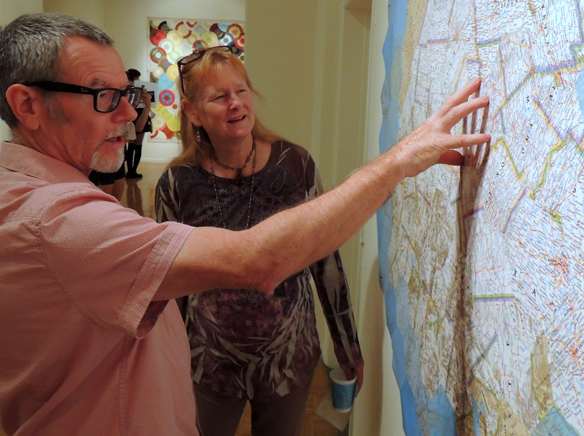For most beginning and intermediate art students, abstract art is somewhat of an enigma. The current exhibit at Grossmont College Hyde Gallery called “Elements” introduced students to the form. It features five San Diego area artists who are masters of abstract: Robert Treat, Steve Gibson, Ann Mudge, Marisol Rendon and David Fobes.
For most beginning and intermediate art students, abstract art is somewhat of an enigma. The current exhibit at Grossmont College Hyde Gallery called “Elements” introduced students to the form. It features five San Diego area artists who are masters of abstract: Robert Treat, Steve Gibson, Ann Mudge, Marisol Rendon and David Fobes.
Jennifer Bennett, art instructor and Prudence Horne, administrator of the gallery, worked together to install and curate the exhibit. On the evening of the “Elements” reception, students brought notebooks into the gallery and visited with the artists.
Students crowded around the work of Ann Mudge, a sculptor who works with wire. Her stainless steel wire pieces hung from the ceiling, turning ever so slightly with the smallest of currents in the room. Her sculptures are a good lesson in how line and space work together in design
“I love to suspend things because of the way they resist gravity and are sensitive to air currents,” Mudge said.
Very different sorts of abstract design were the works of charcoal on paper by Marisol Rendon, who grew up in Columbia. After coming to San Diego 11 years ago, her artistic career took shape. Her depictions of cracks and screws, bones and rocks draw the viewer in.
The works of Rendon could, in some ways, be compared to the psychological vale of Frida Kahlo, a Mexican artist who incorporated her self-image into all her works after an accident that fractured her spine. Rendon, who had worked in psychology before turning to art, bee had fractured her wrist while ice-skating with her daughter.
“I would look at those X-rays of mine and see the screws the doctors had put into my arm to mend the fracture. And those fractures and screws would remind me of psychological breaks in people,” said Rendon.
Rendon said her artwork asks the question, “What is in the gap that cannot be fixed?”
Another artists garnering much attention to his work was David Fobes, whose pieces on canvas, acrylic, and brass grommets are masterpieces of geometrical exactness using circles and other shapes.
Fobes’ quilt-like work of acrylic pieces called “This Side of CRAZY” was of particular interest to Ruth Ann Turner, a visitor to the exhibit.
“I’d like to know how he got these circles so perfect. Circles are hard to do,” she said, leaning in close to look at his work.
“I used a knife on a compass,” Fobes said as he came up to talk with her.
“I’m impressed. That is still difficult to do,” Turner said.
When Turner along with several other people commented on the quilt-like nature of Fobes’ work, the artist said he uses templates. “And wallpaper. From wallpaper books I get from my own sources,” he said.
Fobes’ one piece that attracted the most attention was his “New World Map,” of the 50 states of the union completely mixed up.
“It’s basically a statement of what I think could happen. Notice the subtitle is ‘2192,’” said Fobes, who is an art lecturer at San Diego State University.
“Of course, California has slid into the water,” he said, wryly. “But notice anything about the other states?”
Turner and other people looked closely. Kansas is still in the center, they said.
Fobes nodded. “As before, Lebanon, Kansas is still the geographical center of the United States,” he said.
Fobes’ work, like the other pieces on exhibit now at Hyde Gallery, is a good example of how abstract art can make people feel and notice things about the world they normally would gloss right over.
“Even though abstract art does not represent the way people conventionally see things, it still can be interpreted. And students can see the way texture, colors and design all work together to convey emotion,” said Bennett.
“Elements’ will be on exhibit at Hyde Gallery at Grossmont College, 8800 Grossmont College in El Cajon through Nov. 6. The gallery is open 10 a.m. to 6 p.m., Monday through Thursday, except for holidays. Admission is free and open to the public. Visitor parking is available from the vending machine in Parking Lot 1, Section F.
For more information, visit the gallery website at www.grossmont.edu/artgallery.













